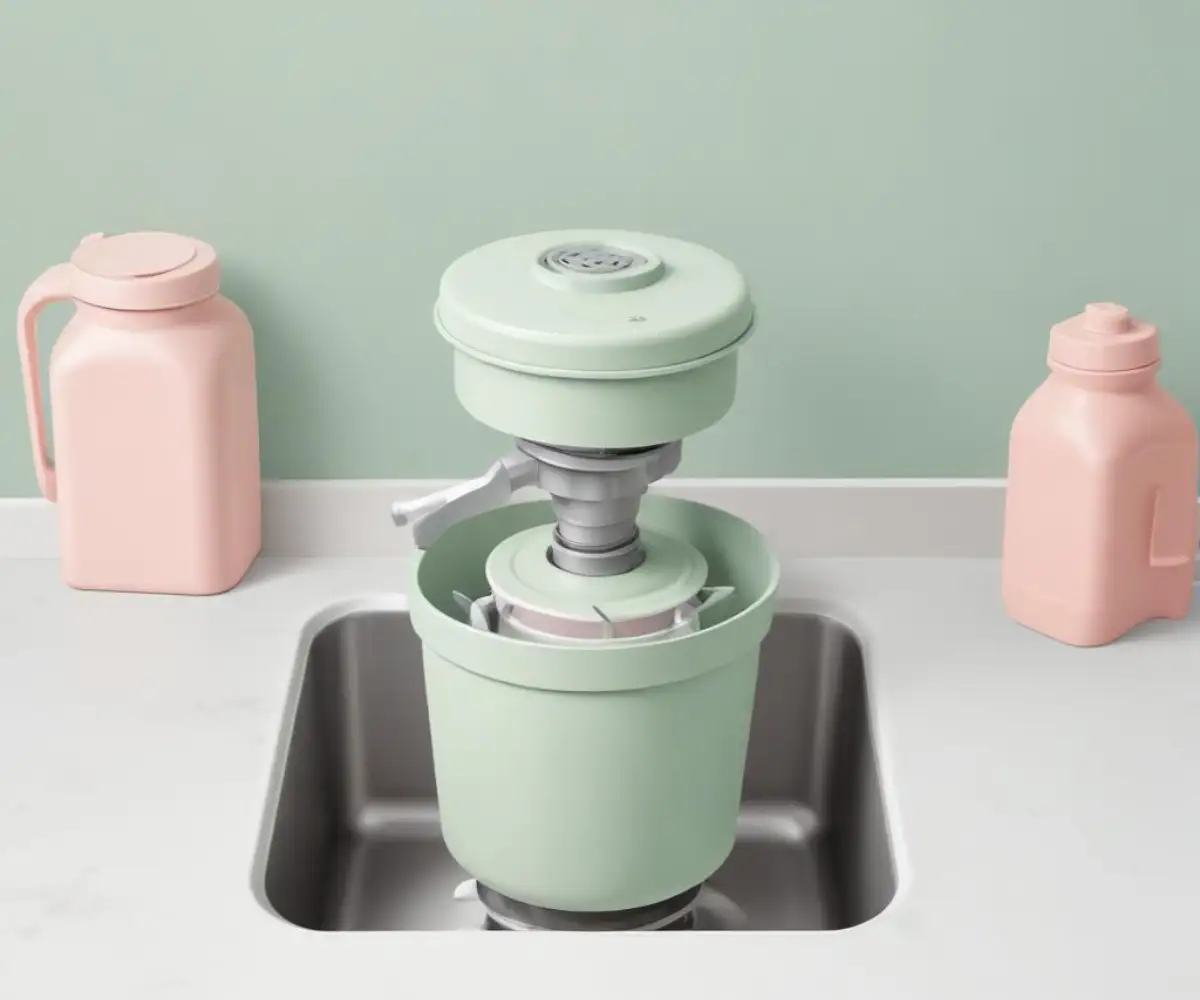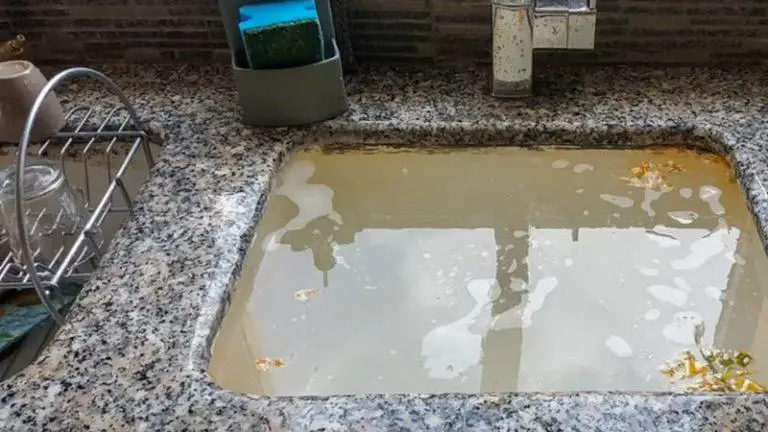Kenmore 60514 Garbage Disposal Problems? Fix Jams and Leaks Now
The Kenmore 60514 garbage disposal is a workhorse in many kitchens, quietly handling food scraps day after day. But when it suddenly stops working, hums ominously, or starts leaking, it can bring your kitchen workflow to a grinding halt.
This guide provides a comprehensive walkthrough to diagnose and solve the most common issues with your Kenmore 60514. Follow these steps to get your disposal back in working order safely and efficiently.
You'll Learn About
Understanding Your Kenmore 60514 Disposal
The Kenmore 60514 is a 1/2 horsepower continuous-feed garbage disposal. This means it’s designed to handle a steady stream of food waste as long as the motor and cold water are running.
Knowing its key parts is the first step to troubleshooting. Inside the main chamber are impeller lugs (often called blades, though they aren’t sharp) that spin and force food particles against a stationary grind ring. On the very bottom of the unit, you’ll find a small red or black reset button and a hexagonal hole for a special wrench to manually turn the motor.
The Most Common Kenmore 60514 Problems (And Why They Happen)
Even the most reliable disposals encounter problems. Most issues with the Kenmore 60514 fall into a few common categories, each with a clear cause and a straightforward solution.
Problem 1: The Dreaded Hum – Motor On, But No Grinding
You flip the switch and hear a low, electric hum, but the disposal isn’t spinning. This is the most frequent issue users face, and it’s almost always caused by a jam.
Fibrous materials like celery stalks or corn husks, hard items like fruit pits, or even a stray piece of silverware can become wedged between an impeller lug and the grind ring. This prevents the motor from turning, but it still receives power, creating the humming sound.
Problem 2: Complete Silence – The Disposal Won’t Turn On
If you get no response at all—no hum, no sound—the issue is electrical. The unit is simply not receiving power. This can be due to a few different reasons.
The most common cause is the unit’s internal overload protector, which has tripped. This safety feature automatically cuts power when the motor overheats, often after struggling with a tough jam. It can also be a tripped circuit breaker in your home’s main electrical panel or a tripped GFCI outlet.
Problem 3: Leaks! Water Where It Shouldn’t Be
Discovering a puddle under your sink is alarming. Leaks from a garbage disposal typically originate from one of three areas.
Leaks from the top are often due to a failed seal at the sink flange, where the disposal connects to the sink drain. Leaks from the side connections usually involve loose or degraded gaskets on the dishwasher hose or main drain pipe. A leak from the very bottom of the unit itself is the most serious, as it often indicates a crack in the housing from corrosion or damage.

Problem 4: Alarming Noises – Grinding, Rattling, and Screeching
Sudden, loud metallic noises mean a foreign object has found its way into the grinding chamber. A coin, bottle cap, or piece of glass is likely bouncing around inside.
Addressing these sounds quickly is crucial to prevent damage to the disposal’s interior. Sometimes, strange vibrations and noises can be as difficult to pinpoint as a high-pitched noise coming from the ceiling, but the source is usually within the unit itself.
Your Step-by-Step Guide to Fixing the Kenmore 60514
With a clear understanding of the potential problems, you can now move on to the solutions. These steps are designed to be performed with basic household tools.
Safety First: Before You Begin
This is the most important step. Before attempting any repairs, you must completely cut power to the garbage disposal. Go to your home’s main electrical panel and flip the circuit breaker that controls the disposal to the “OFF” position.
You can confirm the power is off by trying to turn the disposal on at the wall switch. It should be completely silent.
Solution for a Jammed Disposal (The Humming Problem)
To fix a jam, you will manually dislodge the obstruction. Your Kenmore disposal likely came with an Allen wrench (sometimes called a jam-buster wrench) for this exact purpose.
First, locate the hexagonal opening in the center of the bottom of the disposal. Insert the Allen wrench and turn it back and forth. You will feel resistance, but applying firm, steady pressure will work the motor and impellers, breaking the jam free. Once it moves freely in a full circle, the jam is cleared.
Next, use tongs or pliers—never your hands—to reach into the disposal from the sink drain and remove whatever caused the jam. After removing the object, press the red reset button on the bottom of the unit. You can now restore power at the breaker and test the disposal.
Solution for a Disposal That Won’t Turn On
If the unit is silent, start with the simplest fix. Press the red reset button on the bottom of the disposal firmly until it clicks and stays in.
If that doesn’t work, check your home’s circuit breaker panel to see if the corresponding breaker has been tripped. If it has, flip it back to the “ON” position. If the disposal is still dead, the motor may need more time to cool down. Wait 15 minutes before trying the reset button again. If these steps fail, there could be an issue with the wall switch or the unit’s internal wiring, which may require a professional.
Solution for Leaks
First, identify the exact source of the leak by wiping the unit dry and observing where new drips form. For a leak at the top, use a screwdriver to tighten the three bolts on the mounting ring that secures the disposal to the sink flange.
For leaks at the side connections, check the dishwasher hose and the main drain pipe. Tighten any loose clamps or slip-nut fittings. If tightening doesn’t stop the leak, the rubber gaskets inside these connections may need to be replaced.
If the leak is coming from the bottom of the disposal housing or a visible crack, the unit’s integrity is compromised. Unfortunately, this type of leak is generally not repairable, and the entire disposal will need to be replaced.
Proactive Maintenance: Keeping Your Kenmore 60514 Running Smoothly
Proper use is the key to preventing future problems. A few simple habits can dramatically extend the life of your disposal and keep it running efficiently.
Always run a strong flow of cold water before, during, and for about 30 seconds after grinding. Cold water helps solidify grease and fats, allowing them to be chopped up and washed away rather than coating your pipes. Making the right choices for appliance maintenance is just as critical as choosing the right materials for a major home project, such as in a Weatherlogic vs Zip system comparison.
Garbage Disposal Do’s and Don’ts
To ensure optimal performance and avoid costly repairs, follow these simple guidelines. This table breaks down what should and should not go into your Kenmore 60514.
| What to Do (The “Do’s”) | What to Avoid (The “Don’ts”) |
|---|---|
| Grind small, soft food scraps. | Pour grease, oil, or fat down the drain. |
| Use cold water during operation. | Grind large quantities of potato peels. |
| Grind citrus peels to freshen the unit. | Put in fibrous materials like celery or corn husks. |
| Cut larger scraps into smaller pieces. | Grind large animal bones or seafood shells. |
| Regularly grind hard materials like small chicken bones or ice cubes to scour the chamber. | Use harsh chemical drain cleaners. |
The Cleaning Secret Beyond the Basics
Many older Kenmore models were sold with a feature called “Bio-Charge,” which used enzyme cartridges to help break down waste. While these are largely obsolete, the principle of using beneficial bacteria remains sound. However, physical cleaning is far more important.
For a deep clean, first, use tongs to check for any foreign objects. Then, fill the disposal with ice cubes and a cup of rock salt. Run the disposal with cold water to powerfully scour the inside of the grinding chamber. Finally, cut a lemon or lime in half and grind it to deodorize the unit, leaving your sink smelling fresh. Neglecting strange smells from a disposal can lead to bigger issues, much like how an odd scent under your home might require you to learn how to remove a dead animal from under a deck.
When to Call a Professional vs. DIY
Knowing your limits is key to a successful home repair. You can confidently handle most jams, resets, and minor leak tightenings yourself.
However, you should call a qualified plumber or electrician for certain tasks. If you suspect faulty wiring in the wall switch, if a leak persists after you’ve tightened all connections, or if you need to replace the entire unit and are not comfortable with both plumbing and electrical work, it’s best to leave it to a professional.
Is It Time for an Upgrade?
The Kenmore 60514 is a capable 1/2 HP model, sufficient for most small to medium-sized households. However, if you find it jamming frequently or struggling with the volume of food waste your family produces, an upgrade may be a wise investment.
Modern disposals with 3/4 HP or 1 HP motors offer more grinding power and are less likely to jam. Many also feature advanced sound-dampening technology for quieter operation and components made from more durable stainless steel to resist corrosion. Considering an upgrade can provide a long-term solution to recurring disposal problems.

